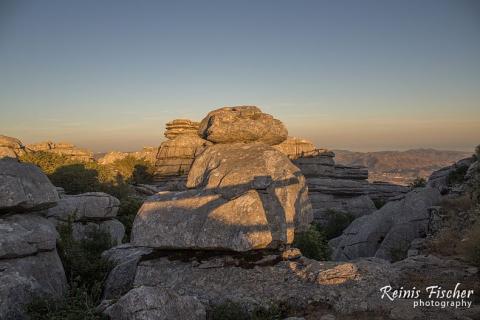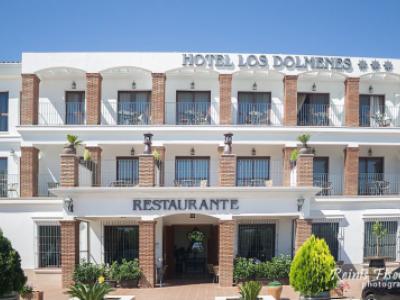El Torcal de Antequera is a nature reserve in the Sierra del Torcal mountain range located south of the city of Antequera, in the province of Málaga off the A45 road in Andalusia, Spain.
It is known for its unusual landforms, and is one of the most impressive karst landscapes in Europe.
It was on our day 4th or 5th in Spain (traveling around region of Andalusia), when El Torcal de Antequera popped on our radar. It was not easy to get there for us, see: In The Searches For El Torcal - Wilderness in Spain, but after all we made it. It was already getting late, and I rushed to make the most of ending golden hour (HDR photography).
El Torcal kind of reflected me memories from our Spontaneously visit to Montserrat Mountain near Barcelona, during our previous trip to Spain (Region of Catalonia), kind of reflected, but was totally different experience. Thus there is one thing common for both - the crazy serpentine road to access these amazing sites.

El Torcal de Antequera
The Sierra del Torcal (or El Torcal) is a small mountain range separating the cities of Antequera and Málaga. It has four geological sections: Sierra Pelada, Torcal Alto, Torcal Bajo and Tajos and Laderas. The highest point in El Torcal is Camorro de las Siete Mesas (1336 m) in the Torcal Alto.
The Jurassic age limestone is about 150 million years old and was laid down in a marine corridor that extended from the Gulf of Cádiz to Alicante between the present Atlantic Ocean and Mediterranean Sea. These seabeds were uplifted to an elevation of over 1300 meters during the Tertiary era, resulting in a modest mountain range of flat-lying limestone, which is rare in Andalucia. Later, a series of fractures, cracks and faults at right-angles (generally NW-SE and NE-SW) were exploited by erosion and produced the alleys between large blocks of limestone visible today. The blocks themselves have been subjected to both dissolution by water (karstification) and freeze-thaw splitting action which, working on the limestone’s horizontal beds, resulted in the various shapes visible today, many of which resemble, and have been named after, everyday objects such as the Sphinx, the Jug, the Camel, the Screw, etc. Other flat surfaces have been karstified into rugged, rocky lands where travel on foot is difficult.

Rock formations
Like many massive limestones, the Torcal includes caves and other underground forms, some of them of historical importance like the Cueva del Toro (Cave of the Bull) with its Neolithic artifacts. Their origins are also related to the dissolution of underground limestone by rainwater.

View towards Antequera
El Torcal supports an impressive array of wildflowers including lilies, nazarenes, red peonies, wild rose trees and thirty varieties of orchid. The many species of reptiles include the Montpelier Snake and Eyed Lizard, both endemic to El Torcal. Other life includes the Griffon vulture, the Spanish Ibex (Andalusian mountain goat), and nocturnal mammals such as badger, weasel and rodents.

Viewing platform at El Torcal
El Torcal is accessible by paved road from the village of Villanueva de la Concepción. A small gift shop and interpretive center at the parking area is the starting point for a short walk to an impressive viewpoint and three color-coded hiking trails of 1.5 km, 2.5 km and 4.5 km length which include many scenic viewpoints.
Because of temperature extremes, most visitation occurs in the spring and fall.

